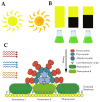Cyanobacteria: A Promising Source of Antifungal Metabolites
- PMID: 37367684
- PMCID: PMC10300848
- DOI: 10.3390/md21060359
Cyanobacteria: A Promising Source of Antifungal Metabolites
Abstract
Cyanobacteria are a rich source of secondary metabolites, and they have received a great deal of attention due to their applicability in different industrial sectors. Some of these substances are known for their notorious ability to inhibit fungal growth. Such metabolites are very chemically and biologically diverse. They can belong to different chemical classes, including peptides, fatty acids, alkaloids, polyketides, and macrolides. Moreover, they can also target different cell components. Filamentous cyanobacteria have been the main source of these compounds. This review aims to identify the key features of these antifungal agents, as well as the sources from which they are obtained, their major targets, and the environmental factors involved when they are being produced. For the preparation of this work, a total of 642 documents dating from 1980 to 2022 were consulted, including patents, original research, review articles, and theses.
Keywords: action mechanism; alkaloids; antifungal agents; cyanobacteria; peptides; secondary metabolites.
Conflict of interest statement
The authors declare no conflict of interest.
Figures




























Similar articles
-
Antibacterial, antifungal and antimycobacterial compounds from cyanobacteria.Biomed Pharmacother. 2017 Jun;90:760-776. doi: 10.1016/j.biopha.2017.04.030. Epub 2017 Apr 15. Biomed Pharmacother. 2017. PMID: 28419973 Review.
-
Eco-friendly biopesticides derived from CO2-Fixing cyanobacteria.Environ Res. 2023 Dec 15;239(Pt 2):117419. doi: 10.1016/j.envres.2023.117419. Epub 2023 Oct 16. Environ Res. 2023. PMID: 37852466 Review.
-
Antifouling potential of cyanobacteria: a mini-review.Biofouling. 2006;22(5-6):317-27. doi: 10.1080/08927010600967261. Biofouling. 2006. PMID: 17110355 Review.
-
Exploitation of marine algae: biogenic compounds for potential antifouling applications.Planta. 2004 Aug;219(4):561-78. doi: 10.1007/s00425-004-1307-5. Epub 2004 Jun 24. Planta. 2004. PMID: 15221382 Review.
-
Antifungal compounds from cyanobacteria.Mar Drugs. 2015 Apr 13;13(4):2124-40. doi: 10.3390/md13042124. Mar Drugs. 2015. PMID: 25871291 Free PMC article.
Cited by
-
The Chemistry of Phytoplankton.Chem Rev. 2024 Dec 11;124(23):13099-13177. doi: 10.1021/acs.chemrev.4c00177. Epub 2024 Nov 21. Chem Rev. 2024. PMID: 39571071 Free PMC article. Review.
-
Cyanobacteria-Fungi Co-Cultures: Which Partner Contributes to Antifungal Activity?Curr Microbiol. 2024 Oct 10;81(11):401. doi: 10.1007/s00284-024-03914-3. Curr Microbiol. 2024. PMID: 39390144 Free PMC article.
-
Algae and Cyanobacteria Fatty Acids and Bioactive Metabolites: Natural Antifungal Alternative Against Fusarium sp.Microorganisms. 2025 Feb 17;13(2):439. doi: 10.3390/microorganisms13020439. Microorganisms. 2025. PMID: 40005804 Free PMC article. Review.
-
Marine Cyanobacteria: A Rich Source of Structurally Unique Anti-Infectives for Drug Development.Molecules. 2024 Nov 10;29(22):5307. doi: 10.3390/molecules29225307. Molecules. 2024. PMID: 39598696 Free PMC article. Review.
References
-
- Kendrick B. Fungi: Ecological Importance and Impact on Humans. eLS. 2011:1–5. doi: 10.1002/9780470015902.a0000369.pub2. - DOI
Publication types
MeSH terms
Substances
Grants and funding
LinkOut - more resources
Full Text Sources

